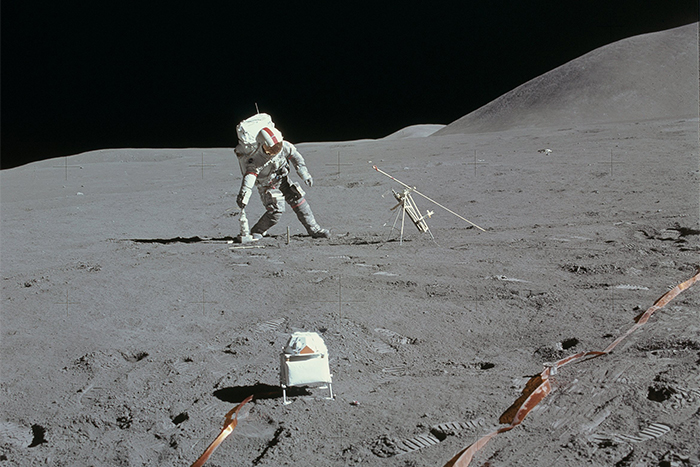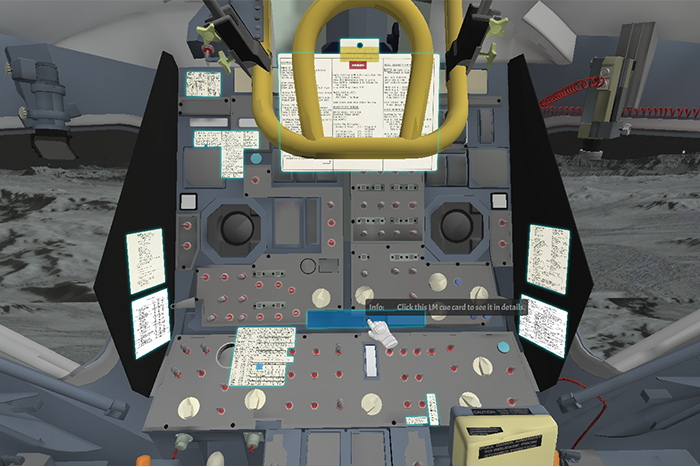In celebration of the 50th anniversary of the Apollo 15 Mission, the Emory Center for Digital Scholarship (ECDS) has launched a new digital learning hub that assembles, preserves and makes available primary source records of Apollo 15 for research, education, history and as an example of a unique human endeavor.
The hub will offer access to a digital archive of Apollo 15 onboard materials, an interactive 3D model of the lunar module and links to reliable primary sources of Apollo history.
Launched July 26, 1971, Apollo 15 was the fourth lunar landing mission and the first extended scientific exploration of the moon. It became the first Apollo mission to carry the Lunar Roving Vehicle to the moon’s surface, which astronauts used to explore the geology of the Hadley–Apennine region.
“We are excited to share this unique collection of primary source documents, including the Apollo 15 Flight Data File, one of the most complete ‘as flown’ Apollo flight archives, shared in the Readux online reading and publishing app,” says Joanna Mundy, digital projects specialist at ECDS. “We have worked with faculty, staff and graduate and undergraduate students across the university since 2016 to build the Hub, which offers support to educators, researchers and students in studying Apollo 15 in its original historical context.”
Tracy L. Scott, senior lecturer in sociology and director of undergraduate research in Emory’s Department of Sociology, is the daughter of Col. David R. Scott, commander of Apollo 15. Her father, who also flew on Gemini 8 and Apollo 9, is one of only 12 people who have ever set foot on the moon.
“For my 8th grade autobiography assignment I wrote, ‘The summer of 1971 I went to camp and my dad went to the moon,’” she recalls. “As an ‘astronaut kid’ I was very nonchalant about the Apollo missions, as were many of us growing up in the communities of the early NASA era between 1962 to 1972.”
“All my friends had fathers who were either astronauts or worked at NASA. Space flights were the ordinary business of everyday life,” Scott continues. “Over time, I’ve come to appreciate the extraordinary nature of these historical events, even as I still view the individuals involved as ordinary people. As a sociologist, I have begun to think more deeply about how this unique social context shaped those of us who lived within it, as well as how it relates to the larger historical landscape of the time.”
Scott has donated her family's papers to Emory's Stuart A. Rose Manuscript, Archives and Rare Book Library, including items documenting the lives of Commander Scott and his family such as correspondence, subject files, photographs, photo albums, printed material, memorabilia, reel-to-reel tapes and audio cassettes. Some of this material is featured in the Apollo 15 Learning Hub. The Rose Library welcomes all visitors who want to build upon their digital learning and engage the archival materials directly. More details are available in the finding aid for the David R. and Anne Lurton Scott papers, 1962-2019.
Scott will also teach a course about the Apollo era in spring 2022 titled Soc489: Moon-Bound: A Sociology of the Apollo Era. The course will explore social-historical contexts of the Apollo era, and students will work with primary source materials from the Apollo 15 Learning Hub and the Rose Library collection.
Woodruff Library exhibit set for fall
In addition to the digital learning hub, this fall an exhibition titled “Apollo 15: Digital Exploration on the 50th Anniversary of the Mission” will open on Level 3 of the Woodruff Library.
The exhibit begins in the entry to the ECDS with materials from the Scott family papers and an interactive kiosk introducing components of the Apollo 15 Learning Hub. The exhibit will continue to the hallway and the rotunda gallery, where visitors can follow the mission to the moon and back through graphic panels, a video display and a planetarium-like projection highlighting extra-vehicular activities.
The exhibit will remain in place through the 2021-22 school year.




